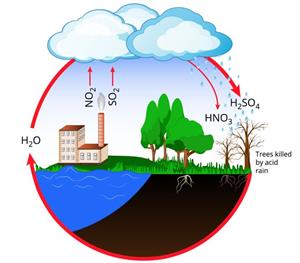PDF chapter test TRY NOW
We all know that clouds are formed of pure water. Sometimes, gases such as sulphur dioxide and nitrous oxide in the atmosphere react with the water and oxygen and fall on the Earth in the form of acid rain, which is also called acid deposition.

Acid rain
The pH of pure rainwater is 5.6, while acid rain has a pH of less than 5.6.
What are the sources of acid rain?
Acid rain is caused by two sources named,
1. Natural sources
- Rotting vegetation
- Erupting volcanoes
2. Human activities
- Burning of fossil fuels
- Cutting trees
- Smoke from vehicles
How is acid rain formed?
The rainwater is usually a little acidic. When rainwater comes to the ground, it reacts with carbon dioxide in the atmosphere and forms carbonic acid.
Acid rain is when rainwater comes to the ground; it reacts with sulphur dioxide or nitrous oxide (released by human activities) forming sulphuric acid and nitric acid, respectively (more acidic in nature) The reaction is as shown below:
The consequences of acid rain:
- It irritates the human beings eyes and skin.
- It inhibits the development of a plant from a seed.
- It changes the soil's fertility and destroys plants and aquatic life.
- It causes the corrosion of many buildings, bridges, etc.
How to prevent acid rain?
- Minimising fossil fuel usage such as petrol, diesel, etc.
- Using compressed natural gas (CNG).
- Using a non-conventional source of energy such as wind, solar energy and biomass.
- Proper disposal of industrial wastes.
